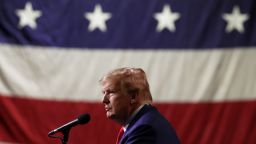Editor’s Note: Peter Bergen is CNN’s national security analyst, a vice president at New America, a professor of practice at Arizona State University, and the host of the Audible podcast “In the Room,” also on Apple and Spotify. He is the author of The Cost of Chaos: The Trump Administration and the World.” The views expressed in this commentary are his own. Read more opinion at CNN.
President Donald Trump’s then-defense secretary, James Mattis, said in 2017 that NATO is the “most successful and powerful military alliance in modern history.”
Yet, at a campaign rally over the weekend, Trump said he wouldn’t come to the aid of NATO members if Russia attacked them, which was the whole point of the alliance in the first place. Trump said, “No, I would not protect you. In fact, I would encourage them to do whatever the hell they want.”
Trump has long criticized European countries in NATO on the rationale that they purportedly don’t pay their fair share. The idea that foreign countries are freeloading off the United States plays well with his base, but Trump either doesn’t understand how NATO works or chooses not to.
In fact, all the countries in NATO pay into a common fund supporting the alliance’s day-to-day workings, and no country is in arrears on those payments.
Meanwhile, in 2014, all NATO countries agreed to spend at least 2% of their GDP on defense by this year.
Every US president since Barack Obama has pressed NATO countries to reach that expenditure level, but at the time of the agreement, only three NATO countries — the US, United Kingdom and Greece — were doing so.
Since the foreign leader often praised by Trump, Russian President Vladimir Putin, launched his full-scale invasion of Ukraine in 2022, particularly NATO’s European members bordering Russia or Ukraine, like Estonia, Lithuania and Romania, have stepped up spending to more than 2%.
The war in Ukraine is also forcing Germany to end its long policy of spending a relatively small amount of its GDP on defense. Hours after Trump’s NATO comments, German Chancellor Olaf Scholz on Monday said his government would meet its commitment to spend 2% of GDP on defense this year.
European countries fear that Putin might not stop at Ukraine if he is victorious and that if a second Trump presidency were indeed to happen, it might gravely imperil NATO.
In fact, defense spending among NATO countries is growing fast. In 2017, NATO European countries and Canada spent around $270 billion on their defense, while the United States spent around $626 billion. As of 2023, European countries and Canada spent $356 billion on defense, while the US spent $743 billion, according to NATO. Of the 31 countries in NATO, 11 now meet the 2% or above expenditure target.
It’s not an accident that during NATO’s 75 years, the US became the most powerful and wealthy country in history. But that thought seems not to have occurred to Trump, who is always looking to attack countries that are supposedly ripping off the US.
Indeed, Trump has had similar beliefs about US allies for almost four decades. In 1987, Trump paid for a full-page ad in the New York Times featuring an open letter in which he claimed, “For decades, Japan and other nations have been taking advantage of the United States…. Make Japan, Saudi Arabia, and others pay for the protection we extend as allies.” Around the same time, Trump gave a speech in New Hampshire, asserting that Japan and Saudi Arabia were “ripping us off.”
These attitudes continued when he was president; Trump was annoyed that while the Germans had the second largest economy in NATO, they then spent only around 1% of their GDP on defense, while the US spent around 4%. Trump interpreted the Germans’ underspending on defense as if he were a landlord collecting on overdue rent. But in NATO, each country decides how much it wants to spend on its own defense, so if a government chooses to spend less than the agreed-upon target of 2% of GDP, the United States isn’t “owed” anything.
When then-German Chancellor Angela Merkel arrived in Washington on her first official visit in March 2017, Trump’s staff produced a chart showing that Germany was supposedly $600 billion in arrears. Trump waved the “invoice” at Merkel, who told Trump, “Don’t you understand this is not real?” according to an account of the meeting in a book I wrote about Trump’s foreign policy, “The Cost of Chaos: The Trump Administration and the World.”
Get Our Free Weekly Newsletter
- Sign up for CNN Opinion’s newsletter
- Join us on Twitter and Facebook
Trump also seems to not care that the only time that NATO’s Article 5 was invoked, triggering the alliance’s collective self-defense, was after his hometown of New York City was attacked on 9/11 , nor does he seem to care that the UK lost 455 soldiers in Afghanistan fighting on behalf of the US-led war there, while Canada lost 158 soldiers, France lost 86, and Germany lost 54.
No matter how wrong-headed it might be, according to his close advisers Trump seems quite serious about getting out of NATO. When I spoke to Trump’s former national security adviser, John Bolton, last summer for the podcast “In the Room with Peter Bergen,” he told me that Trump “would fundamentally reexamine the premise of NATO, which is the predicate for what I think he would do in a second Trump term, which is withdraw the United States from NATO itself.”
That would be a massive mistake. Why a newly elected Trump would choose to try to undercut such a successful alliance or even break it up is a confounding mystery.






